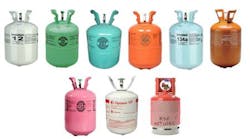Dr. Chuck's Corner: Revisiting Refrigerant Cylinder Safety & Handling
Day after day, HVACR technicians buy, transport, use, and dispose of refrigerant cylinders in addition to working to keep customers satisfied and systems up and running efficiently. The most common container is the standard 30 lb. disposable jug, but larger containers (100 lb.), as well as recovery cylinders are also handled frequently. While there are proposed regulations in the U.S. to move away from disposable cylinders, it is still good practice to periodically revisit safety protocols related to all refrigerant cylinders, regardless of their design or size.
Refrigerant manufacturers and other sources have a wealth of information available.
In addition, the key points listed below should be considered:
- Use proper personal protective equipment, such as safety glasses w/ side shields, gloves, and safety shoes, etc., when handling refrigerant cylinders.
- Store cylinders at temperatures no higher than 125 F. Be especially careful inside service vehicles during summer months.
- When not in use, store cylinders in a protected area, with valves and caps tightly sealed.
- Do not drop, dent, mechanically abuse, or apply direct flame to any cylinder.
- Never force connections. Verify proper hookup of charging hoses and open valves slowly.
- Never attempt to repair or alter containers, valves, or relief devices. Do not refill disposable cylinders.
- Do not use refrigerant to pressurize any system, to check for leaks or for other purposes.
- Know how to correctly determine the maximum fill weight for refrigerant recovery cylinders.
- Use a hand cart or dolly to move large cylinders. Do not roll them.
- For refrigerant blends, always remove liquid from the cylinder when charging, either thru a liquid valve, or by inverting small cylinders.
- Check with local regulation and code experts if you are storing many cylinders at one location.
Refrigerant cylinders are as much a part of our day-to-day work as our wrenches and pressure gauges. Treating the containers that hold compressed, liquified gas with respect and reviewing standard industry handling practices will enable technicians to continue to provide their essential services to customers in an efficient, safe, and productive manner.
About the Author
Charles Allgood
Technical Fellow with Chemours
Charles “Dr. Chuck” Allgood holds a PhD in chemistry, has more than 30 years of experience in the HVACR industry, and is a respected speaker at many industry events. In addition to Chemours, he’s worked for the National Institute of Standards and Technology. Dr. Allgood has held a variety of research, development, business, technical service, training, and applications development positions with Chemours. Most recently, he has focused on the development of low-GWP refrigerants—including Chemours Opteon™ brand refrigerants—and educating industry professionals about the changing regulatory landscape and A2L refrigerants on the market.

